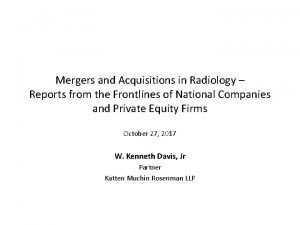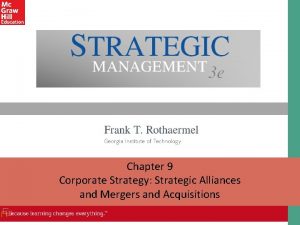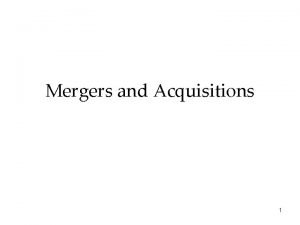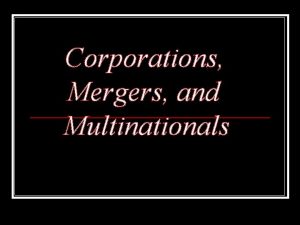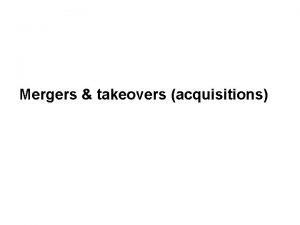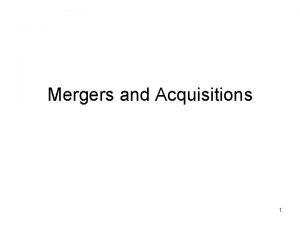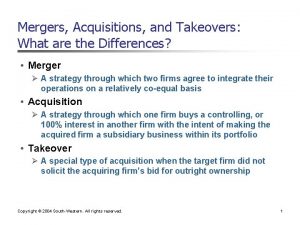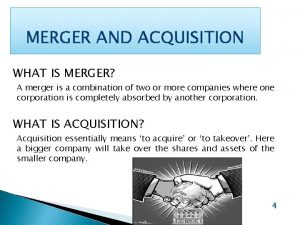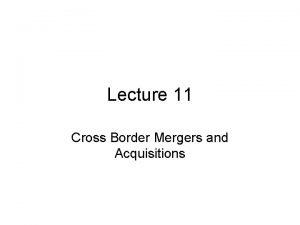Mergers and Acquisitions Varieties of Takeovers Merger Takeovers

















- Slides: 17

Mergers and Acquisitions

Varieties of Takeovers Merger Takeovers Acquisition of Stock Proxy Contest Acquisition of Assets Going Private (LBO)

Is merger and acquisition here to stay? l l l There were previously several waves of merger and acquisition; 1960, and 1985. . The current wave starts at about 1998… and keep going. . Does merger and acquisition become a regular expansion strategy for most firms?

Why M&A becomes common expansion strategy? l l l It is cheaper to buy than to create yourself. It takes less time, and so reduce uncertainty toward future. It can keep all the winning formulas in place, without significantly changing them.

What are the downside risks for M&A? l l l Sometimes you spend too much to buy it. Especially when there are multiple bidders. M&A transactions usually take place within a short period of time, doesn’t allow you to review all the information, and make prudent decisions. Overconfidence takes place. Look too much into bright sides, but think too little on the hidden cost.

Some Evidence on Acquisitions: The Short Run Takeover Successful Unsuccessful Technique Targets Bidders Tender offer 30% Merger 20% Proxy contest 8% 4% 0% NA – 3% 8% – 1% – 5% NA

Some Evidence on Acquisitions: The Long Run l l l In the long run, the shareholders of acquiring firms experience below average returns. Acquirers can be friendly or hostile. The shares of hostile cash acquirers outperformed those of friendly cash acquirers. One explanation is that unfriendly cash bidders are more likely to replace poor management. The cash-financed mergers are different from those stock-financed mergers. (see pp. 812 -5)

Possible explanations of target shareholders’ gain l l l Undervaluation: but unsuccessful bids do not show gain? Tax benefits: the magnitudes of tax benefits should not be so large. Exploitation of bond holders’ value: bond prices show positive sign on announcement date. Exploitation of labor value: some firms cut labor force after mergers, the gain might reflect labor cost down. But research shows merged firms tend to increase hiring, and average salary also increases. Synergy

Synergy l l l Revenue enhancement (operating synergy) Cost reduction (operating synergy) Tax gains (financial synergy) l l The use of tax losses from net operating losses The use of unused debt capacity The use of surplus funds Lower cost of capital (financial synergy)

Synergy l l l Suppose firm A is contemplating acquiring firm B. The synergy from the acquisition is Synergy = VAB – (VA + VB) The synergy of an acquisition can be determined from the usual discounted cash flow model: S T where Synergy = t=1 DCFt (1 + r)t DCFt = DRevt – DCostst – DTaxest – DCapital Requirementst

A cost to stockholders from reduction in risk – Coinsurance effect l Conglomerate mergers usually reduce merged firms’ operating risk, thus decrease default risk and increase debt holders’ value at the expense of equity holders.

Defensive Tactics l l Target-firm managers frequently resist takeover attempts. It can start with press releases and mailings to shareholders that present management’s viewpoint and escalate to legal action. Management resistance may represent the pursuit of self interest at the expense of shareholders. Resistance may benefit shareholders in the end if it results in a higher offer premium from the bidding firm or another bidder.

Reasons for Defensive Tactics l l l Defend against low acquiring prices. Raising bidding prices, or increase bidders’ competition. Eliminate social costs that come with a takeover.

Defensive Tactics that need stockholders’ approval l l Amend corporate charter: change charter to mandate that a merger needs super majority (more than 2/3 of stockholders) approval. Fair price amendment: mandates that merger needs to take place when offered price is fair. (the target firms can request assets to be appraised) Dual-Class Recapitalization: to set different weights of voting rights for different classes of stocks, to make a merger bid difficult. Change the venue (with tougher merger laws) of corporate registration.

Defensive Tactics that do not need stockholders’ approval l Anti-trust law suits. Greenmails: targeted repurchase, usually with a handsome premium. Poison pills: are measures of true desperation to make the firm unattractive to bidders. They reduce shareholder wealth. l One example of a poison pill is giving the shareholders in a target firm the right to buy shares in the merged firm at a bargain price, contingent on another firm acquiring control.

Defensive Tactics l Usually when those tactics are approved by shareholders or employed by management, the stock price drops significantly to reflect the decreasing possibility of a successful merger (and capital gain).

Other Devices and the Jargon of Corporate Takeovers l l Golden parachutes are compensation to outgoing target firm management. Crown jewels are the major assets of the target. If the target firm management is desperate enough, they will sell off the crown jewels. Poison pills are measures of true desperation to make the firm unattractive to bidders. White Knights: the target firms invite potential acquiring firms to come to rescue and compete with current hostile raiders.
 Mergers and takeovers tutor2u
Mergers and takeovers tutor2u Radiology mergers and acquisitions
Radiology mergers and acquisitions Hr issues in mergers and acquisitions
Hr issues in mergers and acquisitions Franchise mergers & acquisitions advisors
Franchise mergers & acquisitions advisors Merger acquisition and corporate restructuring
Merger acquisition and corporate restructuring Mergers in strategic management
Mergers in strategic management Mergers and acquisitions rumors
Mergers and acquisitions rumors Equity strategic alliance example
Equity strategic alliance example What is merger and consolidation
What is merger and consolidation Forbes mergers & acquisitions
Forbes mergers & acquisitions Phalippou private equity
Phalippou private equity Market form of poultry
Market form of poultry Corporations mergers and multinationals
Corporations mergers and multinationals New evidence and perspectives on mergers
New evidence and perspectives on mergers Acquisition and payment cycle
Acquisition and payment cycle Capital acquisition and repayment cycle definition
Capital acquisition and repayment cycle definition United states acquisitions and annexations 1857-1904
United states acquisitions and annexations 1857-1904 Alliances and acquisitions
Alliances and acquisitions

